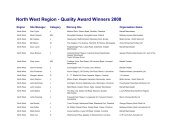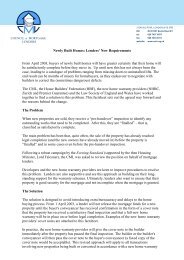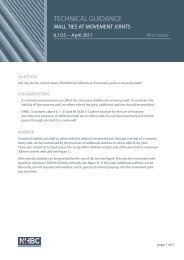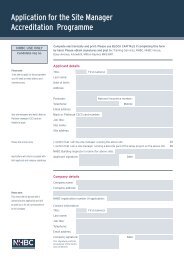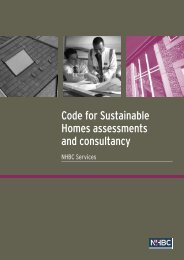June 2010 - NHBC Home
June 2010 - NHBC Home
June 2010 - NHBC Home
Create successful ePaper yourself
Turn your PDF publications into a flip-book with our unique Google optimized e-Paper software.
Issue 47<br />
<strong>June</strong> <strong>2010</strong><br />
3. Obtaining and testing samples of<br />
soils once they have been placed if<br />
no independent testing certification<br />
is available.<br />
Where separate subsoil and topsoil<br />
materials are present in the cover<br />
system, it will be necessary to confirm<br />
the chemical quality of both of these<br />
components.<br />
Though British Standard BS3882:2007<br />
contains details of sampling and<br />
chemical testing that can be undertaken<br />
to determine the characteristics of<br />
topsoil, this is primarily aimed at<br />
assessing its suitability as a growth<br />
medium. Separate chemical testing is<br />
normally required for any contaminants<br />
that may be present posing possible<br />
risks to human health (e.g. heavy<br />
metals, hydrocarbons) and these need<br />
to be provided to <strong>NHBC</strong> as part of the<br />
validation.<br />
The specific requirements for chemical<br />
testing should ideally be discussed and<br />
confirmed with a suitably experienced<br />
consultant or specialist. Remember<br />
that chemical testing of soils can take<br />
up to two weeks to complete. Finalling<br />
of a plot cannot be done until this<br />
testing has been completed.<br />
Where soils are tested off-site and are<br />
confirmed as being suitable (i.e. where<br />
they come from a commercial provider<br />
Trial hole depth from ground level<br />
or another site), it will be necessary<br />
to provide <strong>NHBC</strong> with delivery notes<br />
confirming that the tested and<br />
accepted materials have been delivered<br />
to the site.<br />
Testing frequency<br />
It is important that testing of the cover<br />
system is conducted at a sufficient rate<br />
to give adequate confidence regarding<br />
the depth and quality of the material<br />
used for the remediation.<br />
ACTION<br />
This will depend on a number of<br />
factors, such as number of plots<br />
being constructed and the source of<br />
the material being used, but current<br />
practice across the industry suggests<br />
that for sites with more than 30 plots<br />
testing should be conducted at a rate<br />
of one plot in four, for sites with more<br />
than 20 and up to 30 plots the testing<br />
rate should be one plot in three, for<br />
sites with between 5 and 20 plots one<br />
plot in two should be tested, and where<br />
fewer than five plots are being built it<br />
will be necessary to provide validation<br />
testing for every plot. In addition, for<br />
sites with fewer than three plots it may<br />
be necessary to conduct more than one<br />
test per plot, in order to ensure that<br />
an adequate number of samples are<br />
tested. Again, advice should be always<br />
sought from a suitable consultant or<br />
specialist and <strong>NHBC</strong> staff are available<br />
to discuss and agree acceptable testing<br />
regimes at the early stages of any<br />
project.<br />
Ensure that you are aware of the requirements of <strong>NHBC</strong> Standards<br />
Chapter 4.1 and that proposals for validating cover systems are<br />
agreed with <strong>NHBC</strong>. Also ensure that sufficient time is allowed before<br />
finalling to conduct chemical testing, the preparation, submission and<br />
assessment of the validation report.<br />
Keeping<br />
concrete<br />
in its place<br />
Foundations in shrinkable soils (e.g.<br />
clays), which will be affected by the<br />
removal of trees, need protection from<br />
clay heave.<br />
Piled foundations are often used in<br />
these situations, as they perform much<br />
better, and can often be cheaper, than<br />
deep trench fill foundations.<br />
In order to protect the reinforced<br />
concrete ground beams from the upward<br />
and lateral swelling heave pressures<br />
of the clay as it increases its moisture<br />
content, heave protection materials<br />
such as low density polystyrenes or void<br />
formers must be used.<br />
Placed along the side and under the<br />
beams, the low density polystyrene or<br />
void formers compress and absorb the<br />
pressures, thus preventing damage to<br />
the beams. If damage were to occur<br />
to the ground beams it could in turn<br />
damage the walls and floors above.<br />
However, it has become evident<br />
from a number of expensive claims<br />
over recent years that void formers<br />
and compressible materials are not<br />
working effectively because of poor<br />
workmanship in their installation.<br />
Wet concrete grout can easily ‘leak’ from<br />
poorly fitting void formers or sheets of<br />
compressible materials when ground<br />
beams are poured. This grout can fill the<br />
voids in a void former and thus make it<br />
ineffective when heave occurs.<br />
Small gaps of 5-10mm, where two<br />
sheets of compressible material abut<br />
can, under a head of 500mm concrete,<br />
allow voids to fill over a substantial<br />
length of beam. The beam then has no<br />
heave protection, and the heave forces<br />
are transmitted to the building. This<br />
causes extensive damage, which is very<br />
expensive to repair.<br />
11




